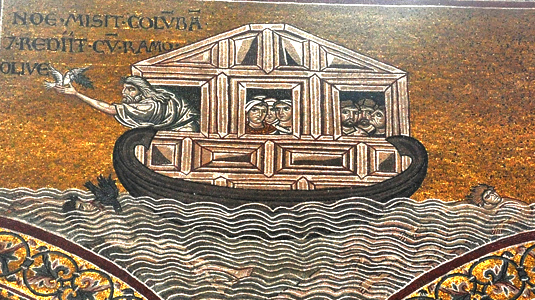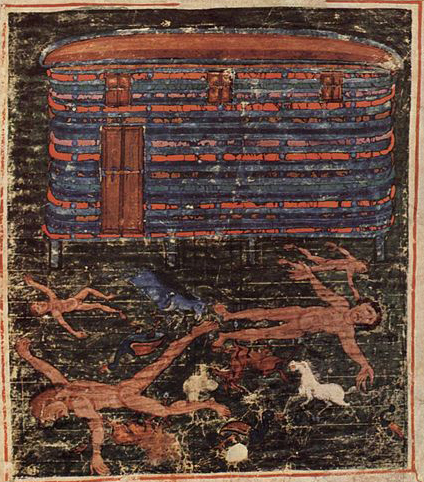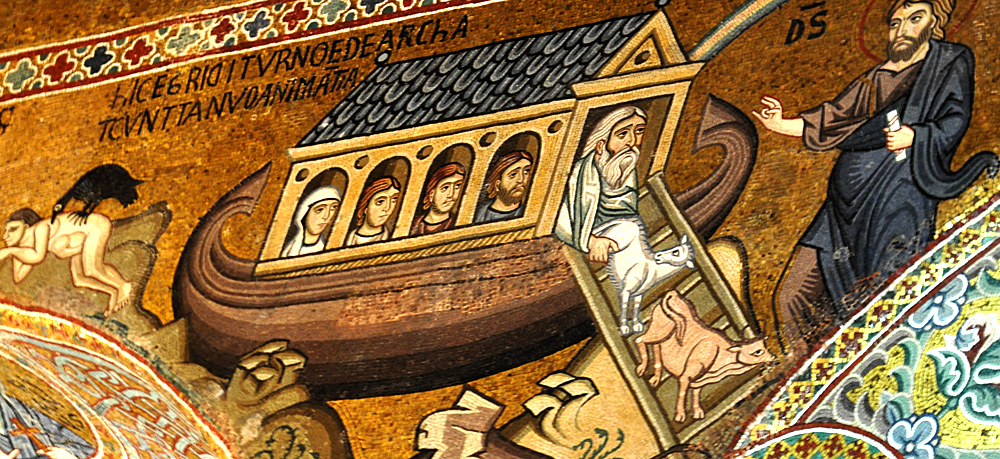|
Noah's story (Genesis 6-9) has been illustrated since at least the 3rd century and possibly the 2nd. In the catacombs paintings and in 4th-century sarcophagi the iconography is fairly constant. The one scene they all illustrate is the return of the dove with the olive branch. Noah is always the sole figure shown in the ark, which is visualized as a square chest with a lid and a hasp
(example). In the catacombs, he stands in orant posture and usually faces the viewer. In a few cases we see him in profile facing the dove, and that is how we usually see him in the sarcophagi. The Noah of the catacombs is always young and beardless, but in the sarcophagi he almost always has a short, square beard like St. Peter's. Later images will keep the beard but without the resemblance to Peter's.
It should be no surprise that the early artists pictured the ark as a chest, because Latin arca means precisely a chest or a safe. In the Ashburnham Pentateuch's illustration of the Flood (at right), the ark is in the shape of a chest but the size of a boat, with windows and a door answering to Genesis 6:16, "make a window in the ark, and in a cubit shalt thou finish the top of it: and the door of the ark thou shalt set in the side." Even as late as the Pomposa Abbey fresco in the 14th century, the ark is visualized as a snug little chest-like structure with a curved top, little locked door, and tiny windows from which the Noah family views the waters. In the second millenium, however, the ark will customarily be boat-shaped and will come under the influence of commentaries that made it a type of the Church.1 The structure on the deck may be shaped like a physical church, and the windows will be shaped like those in a church. This structure is carried on a boat of realistic dimensions but always lacking a rudder. The picture above is an example of the boat with a church-like structure; many others are like the second picture at right, where the structure continues to approximate that of a chest. In one image I have seen, the structure is clearly modeled on the stable in which Jesus is born, with three very large windows for Noah, his wife, and an ox and ass. In the water below, the artist may provide floating corpses, as in the second and third pictures at right. Sometimes, as the mosaic at the top of this page, a raven is pecking at one of the corpses. The conventional explanation for the raven's failure to return to the ark was that it was too busy feeding on those corpses.2 When Noah and his family leave the ark he builds an altar and sacrifices on it: "taking of all cattle and fowls that were clean, [he] offered holocausts upon the altar." In the images the "all cattle" part is ignored and only one animal is sacrificed, a lamb. This of course refers to the sacrifice on the Cross of Jesus, the "Lamb of God." Image cycles on the Flood often include the episode in Genesis 9 where a drunken Noah falls asleep naked and is mocked by Ham but piously covered by the other sons (example). This episode appears to be favored for inclusion because of the commentaries. They make Noah planting vines a figure of Christ founding his Church, the drunkenness a figure of Christ's Passion, the nakedness a figure of Jesus' exposure on the Cross, and Ham's mockery a figure of the Jews who laughed at Jesus crucified.3 Noah is also treated as a type of Christ in these panels in a stained glass window in Canterbury, where the return of the dove is juxtaposed with Christ's resurrection.
Prepared in 2016 by Richard Stracke, Emeritus Professor of English, Augusta University
|
SHOWN ABOVE:
A panel from the 12th-century Noah cycle in the Palatine Chapel, Palermo. To see the entire cycle with commentary, follow this link to the description page. OTHER IMAGES 
From a 4th-century sarcophagus lid: a young, beardless Noah in an ark pictured as a chest with a hinged lid and a hasp. (See the description page for the context and commentary.) 
The ark pictured in the Noah cycle at Monreale. The view of the structure amidships resembles the end of a chest. Bodies float in the water, and a raven pecks at one of them. (See the description page for the rest of the cycle and commentary.) 
From the Ashburnham Pentateuch (6th or 7th century). The ark is shaped like a chest but has windows and a door. Dead bodies float in the waves beneath. (See the description page.)
IMAGE CYCLES
MORE IMAGES
NOTES
|
